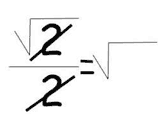Light and Sound
Why's the Common Log So Special?
Why should we use a logarithm with base 10 as opposed to any other base? First, 10 is just a nice number to use. Our whole number system is based on the number 10. This is because there are 10 digits, namely 0 through 9. Base 10 is a very natural and easy choice.
Look and Listen
The eyes and ears respond logarithmically to brightness and loudness. There is also some evidence that pigeons logarithmically perceive time. For more info on this, read birds can think in logarithms at NewScientist.com
What exactly does it mean to respond logarithmically? It means that it is really easy to notice small differences in the small values, but it’s really hard to notice small differences in large values.
For example, if you are in a room with only one candle for light, and a person lights another one, you can easily tell that the room is much brighter. If instead you have a hundred candles in a room and you light one more, it is not so easy to tell that the room is brighter.
A Graphing Tool
A great property of the common log is that if you take the common log of some data, the large values get squished together, but the small ones stay spread apart. This nice behaviour makes the common log very useful for graphing a bunch of small values that are close together and a couple of scattered outliers.
When you transform and graph the data, you can still see all the individual points, but now the graph will fit all on one page. Common logs in particular make it very easy to convert these values back and forth, because our entire number system is based on values of 10.





